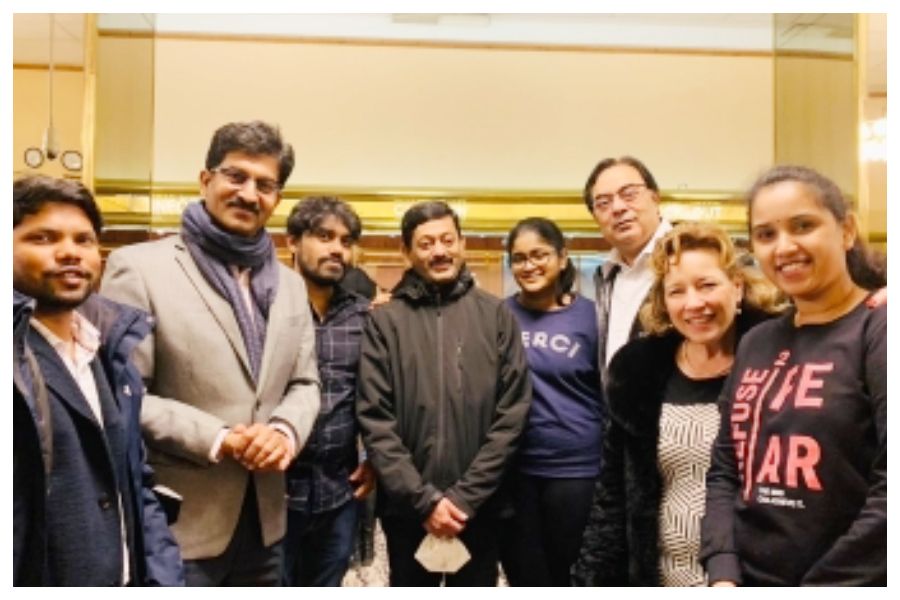National News
160 more Telugu students return home from Ukraine

An additional 160 Telugu students have returned home from the war-torn Ukraine, officials said.
On Friday, the seventh day of evacuation of Indian citizens, 94 students of Telangana and 66 of Andhra Pradesh landed in Delhi and Mumbai.
The officials of the respective state governments in Delhi and Mumbai helped the students in reaching their destinations.
The students hailing from Telangana arrived in the two cities on Friday by 16 flights from Ukraine’s neighbouring countries. The flights had taken off from Bucharest (Romania), Budapest (Hungary), Rzeszow (Poland), Kocise (Slovakia) and Suceava (Romania).
With this, 354 citizens from Telangana have returned home since the evacuation began on February 26.
Gaurav Uppal, Resident Commissioner, Telangana Bhavan and Additional DGP, Intelligence Anil Kumar interacted with Telangana students in Telangana Bhavan.
The government of Telangana has made arrangements to receive all returnees at Delhi and Mumbai airports. The state government also booked air tickets for them from Delhi and Mumbai to Hyderabad.
Meanwhile, with the arrival of 66 students from Andhra Pradesh on Friday, the total number of evacuees belonging to the state reached 270. After their arrival in Delhi and Mumbai, the state government officials booked tickets for them by connecting flights to destinations like Vijayawada, Visakhapatnam, Tirupati, Hyderabad and Bangalore.
The state government officials also received the students in Tirupati, Vijayawada and other airports and made arrangements for their onward journey to their hometowns.
Meanwhile, Venkat Medapati, Andhra Pradesh government’s advisor on NRI affairs, who is in Budapest, met few local Telugu association volunteers, embassy coordinators and few Telugu students from Ukraine.
He said things have streamlined during the last two days.
“There are only 2 flights per day from tomorrow. Hope the embassy will arrange more flights over the next few days like today based on the surge in numbers at the border,” he said.
Eighty more students from Andhra Pradesh are likely to arrive on Saturday.
Crime
Mumbai Shocker: 20-Year-Old Specially-Abled Girl Sexually Assaulted By Over 17 Men; DNA Samples Sent For Testing

Mumbai: A very shocking incident has taken place in South Mumbai. A shocking incident has come to light in South Mumbai where a 20-year-old girl was sexually abused by more than 17 people on different days.
In this Case have been registered against unknown person under 64 (2) (i) (commits rape, on a woman incapable of giving consent) and 64 (2) (k) (commits rape on a woman suffering from mental illness or physical disability) of the Bhartiya Nyaya Sanhita at Cuffe Parade police station, said the police officer. Blood samples of more than 17 suspects named by the victim girl have been taken and sent for DNA testing with the Fetus.
According to FIR, This case was registered on September 22 and in this case, a 17-year-old minor boy has been taken into custody and a 34-year-old married man has been arrested.
Importantly, the NGO Vidhayak Bharati has helped the police in getting the victim girl, who is a special child, who unable to talk proper and deaf. Psi Ashwini Koli – Patil worked hard to detect this crime case.
According to the information given by the police, The victim girl complained to her grandmother that she felt worms moving in her stomach. She was then admitted to Cama Hospital. At that time, it was revealed that the girl was 5 months pregnant. Then the Call received from Cama Hospital to Police was unmarried, mentally retarded and five months pregnant.
In connection with this incident, when Cuffe Parade Police went to the said place to record the statement of the Victim woman. But she unable to record statement. Then Police have recorded statement of her father that she was mentally retarded since she could not speak and deaf. He did not know anything about this and told him that he did not want to file a complaint. Victim Father has refused to give Complaint.
However, on September 22, when she was brought to the police station for further investigation, she ready to filed a complaint against an unknown person. Then her father became ready to file Complaint.
The complainant and Victim’s Father said that some unknown person took advantage of her inability to speak and being mentally retarded, five to six months ago, while her daughter was living at house, and took advantage of this situation and raped and sexually assaulted her, even though he knew that she was not capable of giving consent to physical intercourse. A case has been registered.
It was difficult for psi Ashwini Koli Patil to solve this case. However, Counselor Lila Patade and Councilor Madhura Kodlekar – Counselor from Vidhayak Bharti – Child Rights Organizations helped in recording the girl’s statement using drawing and finger doll therapy for 5 days and 4-5 hours.
During this counseling, the person who was repeatedly named by the victim girl was arrested and a minor boy was detained. While the persons who were repeatedly named in the investigation were shown as suspects and their blood samples were taken for DNA.
Business
Sensex, Nifty edge higher as geopolitical tensions ease

New Delhi, Oct 10: Indian stock markets opened on a flat note but soon moved higher on Friday, supported by positive global sentiment.
The easing of geopolitical tensions in the Middle East and signs of a possible trade deal between the US and India boosted investor confidence.
After the opening bell, the Sensex gained 148 points, or 0.18 per cent, to trade at 82,320 levels. The Nifty also rose 40 points, or 0.16 per cent, to 25,221 levels.
“Though yesterday’s push higher in the second half failed to clear the week’s high, it did serve to invalidate the bearish bias of the evening star candle stick pattern,” market experts said.
“This encourages us to look for 25460, in the days ahead. For the day, inability to push and float above 25215 or direct fall past 25113, could render the trend sideways, but may not call for a break of 24982 right away,” they added.
In the broader market, the Nifty Midcap 100 index inched up 0.18 per cent, while the Nifty Smallcap 100 advanced 0.28 per cent — indicating healthy participation from mid- and small-cap stocks.
Among the sectoral indices, Nifty Metal was the worst performer, slipping 1.4 per cent. It was followed by weakness in Auto, Pharma, and Healthcare stocks.
On the other hand, sectors such as Banking, Energy, FMCG, IT, Consumer Durables, Oil & Gas, and Realty were trading with gains.
In the Sensex pack, Power Grid, State Bank of India, NTPC, Adani Ports, and Asian Paints were among the top gainers.
Meanwhile, Tata Steel, TCS, Bajaj Finance, M&M, and HCL Tech were trading in the red.
“The overall market environment is turning positive. Globally, the GAZA peace accord signals end to the conflict and reduction of geopolitical risk from the region,” analysts said.
“Domestically, there are indications of a trade deal between US and India with India ‘rebalancing’ its oil purchases,” they added.
According to market analysts, these positive developments and the shift in FII strategy ( FIIs were buyers in the cash market in the last three trading days) bode well for the market.
Crime
From Saree Shop Heist To Terror Funding: Maharashtra ATS Raids 19 Pune Locations Of ISIS Terror Module, Questions Suspects Linked To ISIS Operative

Mumbai: In a major development in the ongoing probe into the Pune ISIS module, the Maharashtra Anti-Terrorism Squad (ATS), in coordination with Pune police, carried out extensive search operations across the city on Thursday.
The raids targeted the residences and offices of 19 suspected individuals in Kondhwa, Khadak, Khadki, Wanwadi, and Bhosari, officials said. ATS teams from Mumbai and Pune conducted simultaneous searches to uncover digital evidence, documents, and communication devices linked to the module’s network. Several suspects were taken into custody for questioning, though authorities did not confirm any fresh arrests or seizures. Investigations are ongoing.
According to ATS, the operations were linked to C.R. No. 7/2023, investigating individuals previously arrested for alleged involvement in a sleeper ISIS module operating in Maharashtra. Sources said the raids targeted the residences and offices of the suspects, who are believed to have close links with ISIS operative Talha Liyakat Ali Khan (37). Khan was arrested by the National Investigation Agency (NIA) after a two-year international manhunt. He was intercepted at Mumbai airport in May this year while attempting to return to India from Indonesia.
On June 4, 2025, the Maharashtra ATS arrested Khan from Arthur Road Jail in Mumbai, where he was held in NIA custody, in connection with the April 8, 2023, Satara saree showroom robbery. Khan is alleged to have raised funds and facilitated the purchase of firearms used in the heist, in which Rs 1 lakh was looted and the perpetrators escaped on a motorcycle. He is the fourth individual to be arrested in the case. Officials said the stolen proceeds were reportedly channelled to finance ISIS-linked terror activities.
Sources said that during custody, Khan made several significant disclosures aiding the investigation. Following his statements, the ATS conducted search operations on Thursday. The individuals whose premises were searched are under ATS scrutiny and are believed to be close associates of Khan. Some suspects were reportedly in contact with him during the two years he was absconding and are believed to have been involved, directly or indirectly, in radicalisation and providing logistical support to the ISIS-linked terror module.
Investigations by NIA and ATS revealed that Khan, along with co-accused Fayaz Shaikh, played a key role in raising funds for the Pune ISIS terror module and in organising a secret IED workshop in Pune’s Kondhwa area in April 2022.During this workshop, members of the ISIS module allegedly fabricated and tested improvised explosive devices (IEDs). The session was reportedly attended by several accused, including Zulfikar Barodawala, Mohammed Imran Khan, Mohammed Yunus Saki, Abdul Kadir Pathan, Simab Kazi, Shamil Nachan, Akif Nachan, and Shahnawaz Alam, among others.The suspects were reportedly involved in radicalisation, recruitment and fabrication of explosive devices as part of a larger terror conspiracy.
The plot, which could have posed a serious threat to national security, came to light in 2023 when Pune police detained two suspects from Kothrud in a bike theft case after searches of their residence and subsequent investigation revealed their alleged links to ISIS operatives, leading to the case being transferred to the Maharashtra ATS and later to the National Investigation Agency (NIA).
Officials said Khan and Fayaz Sheikh went underground after the Pune ISIS module was dismantled in 2022. Between July and August that year, the duo left India with their families, reportedly seeking employment in Oman. After being declared wanted by Indian agencies, Omani authorities ordered them to leave the country or face deportation. The pair then traveled to Iran, where they were detained on December 8, 2024, and interrogated for five months until May 5, 2025. In the following days, they reached Indonesia but were initially denied entry. While attempting to return to India secretly from Jakarta in May 2025, they were intercepted by the Bureau of Immigration at Mumbai International Airport (T2) and subsequently taken into NIA custody.
The ATS has said that the investigation into Khan’s network is ongoing, Further questioning and analysis of the seized digital evidence are expected to provide more leads in the case.
-

 Crime3 years ago
Crime3 years agoClass 10 student jumps to death in Jaipur
-

 Maharashtra1 year ago
Maharashtra1 year agoMumbai Local Train Update: Central Railway’s New Timetable Comes Into Effect; Check Full List Of Revised Timings & Stations
-

 Maharashtra12 months ago
Maharashtra12 months agoMumbai To Go Toll-Free Tonight! Maharashtra Govt Announces Complete Toll Waiver For Light Motor Vehicles At All 5 Entry Points Of City
-

 Maharashtra1 year ago
Maharashtra1 year agoFalse photo of Imtiaz Jaleel’s rally, exposing the fooling conspiracy
-

 National News12 months ago
National News12 months agoMinistry of Railways rolls out Special Drive 4.0 with focus on digitisation, cleanliness, inclusiveness and grievance redressal
-

 Maharashtra11 months ago
Maharashtra11 months agoMaharashtra Elections 2024: Mumbai Metro & BEST Services Extended Till Midnight On Voting Day
-

 National News1 year ago
National News1 year agoJ&K: 4 Jawans Killed, 28 Injured After Bus Carrying BSF Personnel For Poll Duty Falls Into Gorge In Budgam; Terrifying Visuals Surface
-

 Crime12 months ago
Crime12 months agoBaba Siddique Murder: Mumbai Police Unable To Get Lawrence Bishnoi Custody Due To Home Ministry Order, Says Report












